端口镜像span、rspan实现数据检测
2013-04-19 23:56
471 查看
端口镜像span、rspan(华为)
RSPAN (Remote Switched Port Analyzer,远程交换端口分析),即远程端口镜像,远程端口镜像(RSPAN)是本地端口镜像(SPAN)的扩展,突破了被镜像端口和镜像端口必须在同一台交换机上的限制,使被镜像端口和镜像,端口可以跨越网络中的多个设备,从而方便网管人员对远程交换机设备进行管理。
在我们的网络中,最为可靠的设备要数防火墙了,通过我们的精心配制安全方案,他确实能给我们带来不错的效果,但这还是远远不够的,像不经过防火前的攻击它还是无能为力的(来自内部网络的攻击、不经过防火墙直接通过电话线等上网的主机有可能就成为了别人攻击的跳板主机),一种叫做数据驱动式的攻击(内含逻辑炸弹),内网主机下载下来携带病毒木马的文件包,还有一些加密后的攻击,这些都是防火墙无能为力的,这时我们可以使用一种叫做ids的检测机制,它重在检测没有什么防御功能,升级后的ids叫做ips,相比ids它重在防御,当别人攻击它是它会做出回应常见的ids有:hids、session-wall、snort这些都是软件,需要安装在主机上,使用起来既麻烦价格又不便宜,还有一种网络ids叫做nids,它只需要安装在网络设备上便可做到对数据的检测,但是它往往不能做到对全网信息的检测(交换机是点到点通讯),在交换机上有一种概念叫端口镜像span便可以解决这个问题。
端口镜像,需要在交换机上设置镜像的源端口(被检测数据来时所经过的端口)和目标端口(链接检测设备的端口),但这只是对检测设备所连接的交换机数据的检测,对于网络上的其他交换的数据检测我们要采用rspan(远程的交换端口分析),我们只需要在网络中心的交换机上连接一台检测设备便可以做到对全网信息的检测。
Rspan中各个交换机和交换机端口的作用:
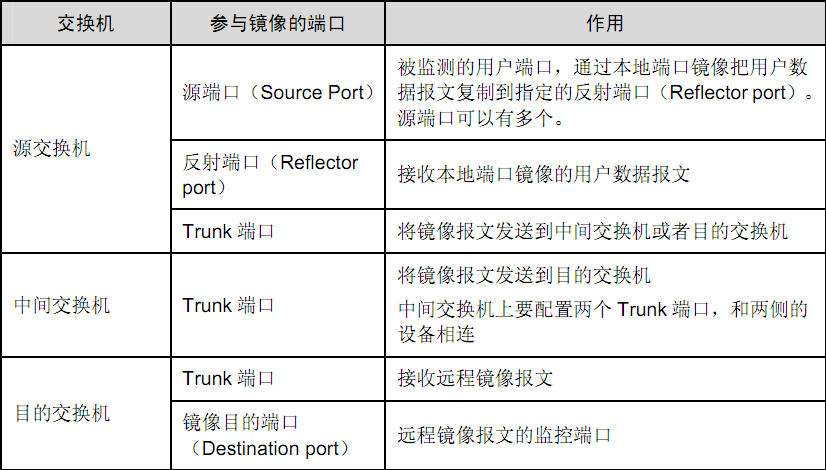
本地端口镜像配置命令:
创建端口镜像组
mirroring-group group-id local
进入镜像目的端口的以太
interface interface-type interface-number
定义当前端口为镜像目的端口
monitor-port
进入镜像源端口的以太网
interface interface-type interface-number
配置镜像源端口,同时指定被镜像报文的方向
mirroring-port { inbound |outbound | both }
或者用这种方法:
创建端口镜像组
mirroring-group group-id local
配置镜像目的端口
mirroring-group group-id
monitor-port monitor-port
配置镜像源端口,同时指定被镜像报文的方向
mirroring-group group-id
mirroring-port mirroring-port-list { both | inbound | outbound }
下面是一个本地端口span镜像案例:
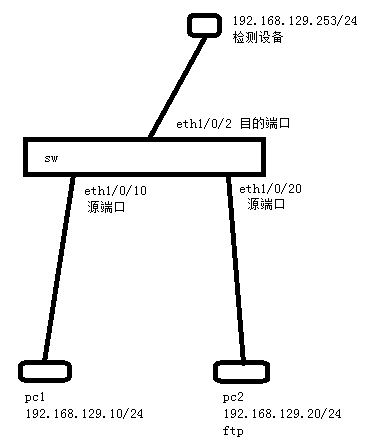
实验设备:
二层交换机sw
两个防火墙作pc
检测设备是一台linux主机安装有wireshark
参考配置:
在linux安装一个wireshark抓包工具,当做sw上的检测设备
[sw]dis mirroring-group all
mirroring-group 1:
type: local
status: active
mirroring port:
Ethernet1/0/10 both
Ethernet1/0/20 both
monitor port: Ethernet1/0/2
在pc2上建一个ftp服务器并建立用户:
[pc2]ftp server enable
[pc2]local-user user1
[pc2-luser-user1]password 123456
[pc2-luser-user1]service-type ftp
从pc1上登录pc2的ftp服务器:
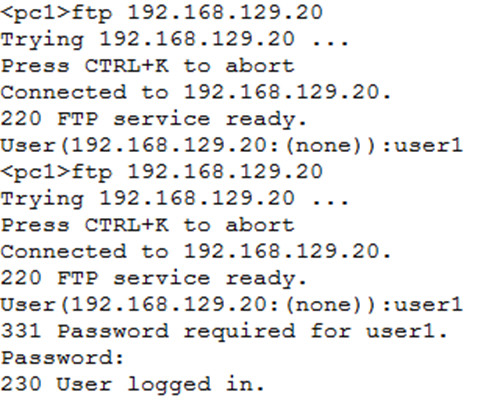
在检测设备上检测到登录信息:
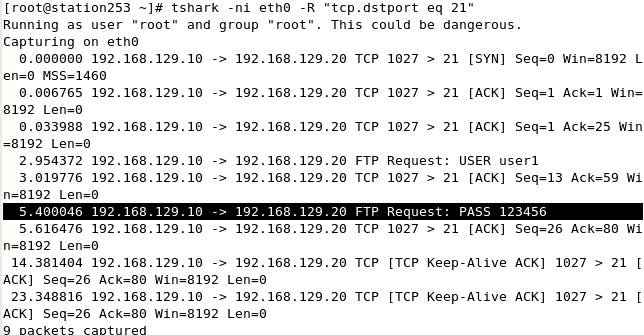
接下来是rspan的一个小案例:
基本配置命令:
源交换机上的配置过程
创建 Remote-probe vlan
vlan vlan-id
定义当前VLAN 为Remote-probe VLAN
remote-probe vlan enable
进入与中间交换机或目的交换机相连的端口视图
interface interface-type interface-number
配置当前端口类型为 Trunk
port link-type trunk
port trunk permit vlan remote-probe-vlan-id
配置远程源镜像组
mirroring-group group-id remote-source
配置远程镜像源端口
mirroring-group group-id mirroring-port mirroring-port-list { inbound | outbound }
配置远程反射端口
mirroring-group group-id reflector-port reflector-port
配置远程源镜像组的remote-probe vlan
mirroring-group group-id remote-probe vlan remote-probe-vlan-id
中间交换机配置过程:
创建 Remote-probe vlan
vlan vlan-id
定义当前VLAN 为Remote-probe VLAN
remote-probe vlan enable
进入与中间交换机或目的交换机相连的端口视图
interface interface-type interface-number
配置当前端口类型为 Trunk
port link-type trunk
port trunk permit vlan remote-probe-vlan-id
目的交换机上配置过程:
创建 Remote-probe vlan
vlan vlan-id
定义当前VLAN 为Remote-probe VLAN
remote-probe vlan enable
进入与中间交换机或目的交换机相连的端口视图
interface interface-type interface-number
配置当前端口类型为 Trunk
port link-type trunk
port trunk permit vlan remote-probe-vlan-id
配置远程目的镜像组
mirroring-group group-id remote-destination
配置远程镜像目的端口
mirroring-group group-id monitor-port monitor-port
配置远程源镜像组的 remote-probe vlan
mirroring-group group-id remote-probe vlan remote-probe-vlan-id
实验拓扑:
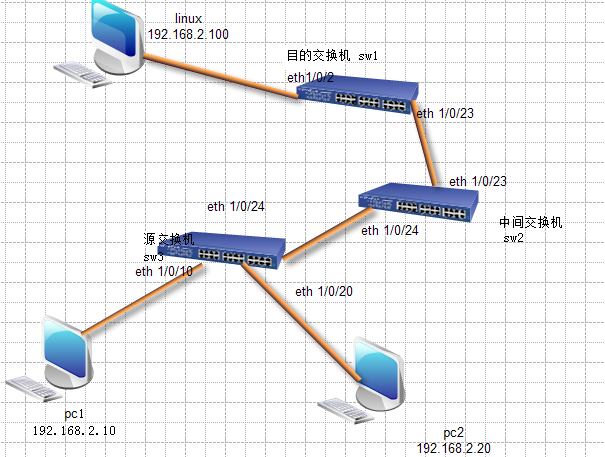
实验目的:
检测设备能检测到pc1访问pc2的数据
参考配置:
目的交换机:
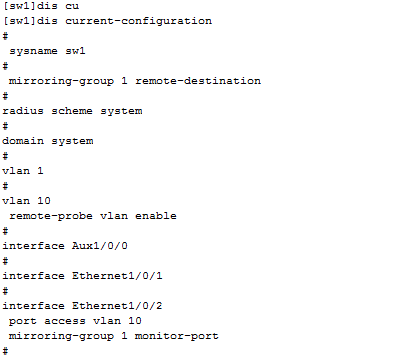


中间交换机:

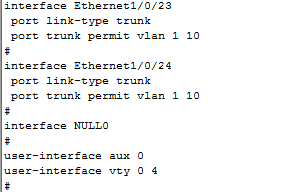
源交换机:



抓包测试结果:

RSPAN (Remote Switched Port Analyzer,远程交换端口分析),即远程端口镜像,远程端口镜像(RSPAN)是本地端口镜像(SPAN)的扩展,突破了被镜像端口和镜像端口必须在同一台交换机上的限制,使被镜像端口和镜像,端口可以跨越网络中的多个设备,从而方便网管人员对远程交换机设备进行管理。
在我们的网络中,最为可靠的设备要数防火墙了,通过我们的精心配制安全方案,他确实能给我们带来不错的效果,但这还是远远不够的,像不经过防火前的攻击它还是无能为力的(来自内部网络的攻击、不经过防火墙直接通过电话线等上网的主机有可能就成为了别人攻击的跳板主机),一种叫做数据驱动式的攻击(内含逻辑炸弹),内网主机下载下来携带病毒木马的文件包,还有一些加密后的攻击,这些都是防火墙无能为力的,这时我们可以使用一种叫做ids的检测机制,它重在检测没有什么防御功能,升级后的ids叫做ips,相比ids它重在防御,当别人攻击它是它会做出回应常见的ids有:hids、session-wall、snort这些都是软件,需要安装在主机上,使用起来既麻烦价格又不便宜,还有一种网络ids叫做nids,它只需要安装在网络设备上便可做到对数据的检测,但是它往往不能做到对全网信息的检测(交换机是点到点通讯),在交换机上有一种概念叫端口镜像span便可以解决这个问题。
端口镜像,需要在交换机上设置镜像的源端口(被检测数据来时所经过的端口)和目标端口(链接检测设备的端口),但这只是对检测设备所连接的交换机数据的检测,对于网络上的其他交换的数据检测我们要采用rspan(远程的交换端口分析),我们只需要在网络中心的交换机上连接一台检测设备便可以做到对全网信息的检测。
Rspan中各个交换机和交换机端口的作用:

本地端口镜像配置命令:
创建端口镜像组
mirroring-group group-id local
进入镜像目的端口的以太
interface interface-type interface-number
定义当前端口为镜像目的端口
monitor-port
进入镜像源端口的以太网
interface interface-type interface-number
配置镜像源端口,同时指定被镜像报文的方向
mirroring-port { inbound |outbound | both }
或者用这种方法:
创建端口镜像组
mirroring-group group-id local
配置镜像目的端口
mirroring-group group-id
monitor-port monitor-port
配置镜像源端口,同时指定被镜像报文的方向
mirroring-group group-id
mirroring-port mirroring-port-list { both | inbound | outbound }
下面是一个本地端口span镜像案例:

实验设备:
二层交换机sw
两个防火墙作pc
检测设备是一台linux主机安装有wireshark
参考配置:
在linux安装一个wireshark抓包工具,当做sw上的检测设备
[sw]dis mirroring-group all
mirroring-group 1:
type: local
status: active
mirroring port:
Ethernet1/0/10 both
Ethernet1/0/20 both
monitor port: Ethernet1/0/2
在pc2上建一个ftp服务器并建立用户:
[pc2]ftp server enable
[pc2]local-user user1
[pc2-luser-user1]password 123456
[pc2-luser-user1]service-type ftp
从pc1上登录pc2的ftp服务器:

在检测设备上检测到登录信息:

接下来是rspan的一个小案例:
基本配置命令:
源交换机上的配置过程
创建 Remote-probe vlan
vlan vlan-id
定义当前VLAN 为Remote-probe VLAN
remote-probe vlan enable
进入与中间交换机或目的交换机相连的端口视图
interface interface-type interface-number
配置当前端口类型为 Trunk
port link-type trunk
port trunk permit vlan remote-probe-vlan-id
配置远程源镜像组
mirroring-group group-id remote-source
配置远程镜像源端口
mirroring-group group-id mirroring-port mirroring-port-list { inbound | outbound }
配置远程反射端口
mirroring-group group-id reflector-port reflector-port
配置远程源镜像组的remote-probe vlan
mirroring-group group-id remote-probe vlan remote-probe-vlan-id
中间交换机配置过程:
创建 Remote-probe vlan
vlan vlan-id
定义当前VLAN 为Remote-probe VLAN
remote-probe vlan enable
进入与中间交换机或目的交换机相连的端口视图
interface interface-type interface-number
配置当前端口类型为 Trunk
port link-type trunk
port trunk permit vlan remote-probe-vlan-id
目的交换机上配置过程:
创建 Remote-probe vlan
vlan vlan-id
定义当前VLAN 为Remote-probe VLAN
remote-probe vlan enable
进入与中间交换机或目的交换机相连的端口视图
interface interface-type interface-number
配置当前端口类型为 Trunk
port link-type trunk
port trunk permit vlan remote-probe-vlan-id
配置远程目的镜像组
mirroring-group group-id remote-destination
配置远程镜像目的端口
mirroring-group group-id monitor-port monitor-port
配置远程源镜像组的 remote-probe vlan
mirroring-group group-id remote-probe vlan remote-probe-vlan-id
实验拓扑:

实验目的:
检测设备能检测到pc1访问pc2的数据
参考配置:
目的交换机:



中间交换机:


源交换机:



抓包测试结果:

相关文章推荐
- 远程端口镜像(span)和本地端口镜像(rspan)
- 端口镜像的SPAN与RSPAN简介及案例
- 将一个字节数据进行高低位镜像对调的实现函数
- Java Swing实现JTable检测单元格数据变更事件的方法示例
- 快来看啊-cisco端口镜象详解(span,vspan,rspan )
- Linux如何实现镜像端口
- 基于Hadoop和CDC的重复数据检测实现
- 跨站用asp实现数据提交检测
- java实现调用nc检测远程服务器端口可用性
- 端口数据[精通WindowsSocket网络开发-基于VC++实现]第二章——TCP/IP简介
- Schmid Telecom选择StoreAge SVM实现数据镜像保护
- Cisco Catalyst交换机端口镜像(SPAN)技术
- py-faster-rcnn + ZF 实现自己的数据训练与检测(二)
- SPAN 端口镜像
- arista 交换机镜像端口配置(将某一端口的数据转发到指定端口)
- Cisco Catalyst交换机端口镜像(SPAN)技术
- Rsync实现异地数据镜像的简单配置
- 快来看啊-cisco端口镜象详解(span,vspan,rspan )
- YOLOv2训练自己的数据来实现人脸检测详细步骤
- C语言实现FTP(C/S)协议(ls命令和download命令)用两个端口实现(命令端口和数据端口)
